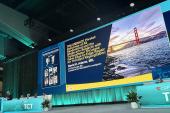Tri.Fr Trial Affirms Quality-of-Life Impact of Tricuspid TEER
As in the TRILUMINATE Pivotal trial, those benefits weren’t accompanied by significant reductions in harder outcomes.

LONDON, England—Transcatheter edge-to-edge repair of a leaky tricuspid valve (T-TEER) significantly improves how patients with symptomatic, severe tricuspid regurgitation (TR) fare over 1 year, results of the randomized Tri.Fr trial confirm.
Compared with guideline-directed medical therapy (GDMT) alone, adding T-TEER boosted the proportion of patients who had an improvement in a clinical composite score that included NYHA functional class, a patient global assessment, and CV hospitalization or death at 1 year (74.1% vs 40.6%; P < 0.0001), Erwan Donal, MD, PhD (Hospital Pontchaillou of Rennes, France), reported here at the European Society of Cardiology Congress 2024.
As in the TRILUMINATE Pivotal trial released last year, those gains were not accompanied by improvements in harder clinical outcomes like MACE and cardiovascular death.
“Transcatheter edge-to-edge repair is something that probably we have to consider in patients with severe tricuspid regurg, but on top of optimized medical treatment,” Donal said during a press conference. “We still have to optimize medical treatment because when we compare the result that we got and the result from previous studies and registries, it’s so impressive to see that the death rate and the rate of hospitalization is much lower in this trial than before.
“So on top of the medical treatment, T-TEER seems to be efficient and improve dramatically the quality of life and the risk for the patients,” he commented.
On top of the medical treatment, T-TEER seems to be efficient and improve dramatically the quality of life and the risk for the patients. Erwan Donal
Donal suggested that there’s no difference in hard clinical outcomes at 1 year both because of lower-than-expected event rates and because of the short duration of follow-up. The investigators plan to check in with patients at 2 and 5 years, which may provide additional insights into an impact on events like heart failure hospitalization and death.
Commenting for TCTMD, Christopher Kramer, MD (University of Virginia, Charlottesville), vice president of the American College of Cardiology, said Tri.Fr adds “to the amount of evidence that suggests that one can palliate TR with edge-to-edge repairs and improve quality of life and the ability to do activities of daily living. So in older patients who are symptom-limited by severe TR, this is an option that [can improve] not their lifespan necessarily, but the quality of their remaining years.”
Tri.Fr Trial
Tricuspid regurgitation, which is increasing in prevalence among older individuals, is a “marker of bad prognosis” independent of LVEF and pulmonary pressures, “but the question is: is it a target for a specific treatment?” Donal said, adding that “evidence [is] missing.”
Previously, the TRILUMINATE Pivotal trial showed that TEER with the TriClip device (Abbott) safely reduces the severity of regurgitation and improves quality of life in patients with symptomatic severe TR.
Tri.Fr, conducted at 24 centers in France and Belgium, is an investigator-initiated, open-label trial that provides additional insights into the impact of the procedure. The researchers randomized 300 patients (mean age 78 years; 54% women) who had symptomatic severe secondary TR despite use of medical therapy, were stable for at least 30 days, and were not eligible for surgery to optimal medical treatment alone or optimal medical treatment plus tricuspid TEER using the TriClip device.
Overall, 40% of the patients had been hospitalized for heart failure in the year before the study and 15% had a cardiac implantable electronic device in place.
The primary endpoint of the trial was a clinical composite score, which takes into account changes in NYHA class, a patient global assessment (PGA) in which participants are asked how they feel, and the occurrence of CV hospitalization or death. Improvement was defined as a lack of CV hospitalization/death and favorable changes in NYHA class and/or the PGA, with patients considered unchanged if there was no CV hospitalization/death and no changes in NYHA class or the PGA and worsened if there was CV hospitalization/death or a decrease in NYHA class or the PGA.
In addition to having a greater likelihood of improvement, patients who underwent T-TEER were less likely to be unchanged (5% vs 12%) or worsened (20% vs 48%). They were also more likely to see at improvement in the PGA score (74.6% vs 39.5%; P < 0.0001).
The procedure significantly reduced the severity of TR, with patients who underwent TEER being more likely to have a TR grade < 4+ at 1 year compared with those who were treated with medical therapy alone (93.2% vs 46.5%; P < 0.0001).
TR doesn't necessarily kill you. . . . It prevents you from walking upstairs, walking your dog, doing the things that people like to do. So it's life-limiting. Christopher Kramer
Quality of life was better after T-TEER as well. Mean Kansas City Cardiomyopathy Questionnaire overall summary score at 1 year was 69.9 in the intervention arm and 55.4 in the control arm (P < 0.001).
Moreover, the investigators looked at the impact of T-TEER on a hierarchical composite endpoint that included all-cause mortality or tricuspid valve surgery, time to heart failure hospitalization, and an improvement of at least 15 points in KCCQ score at 1 year. The intervention significantly improved this endpoint, as indicated by a win ratio of 2.06 (95% CI 1.38-3.08).
In terms of safety, there were no periprocedural deaths among patients who underwent T-TEER and one in-hospital death (0.6%). In-hospital complications and single-leaflet device attachments were observed in 8.0% and 5.2%, respectively.
What About Hard Outcomes?
Although T-TEER was associated with numerically higher rates of freedom from MACE (84% vs 80%) and CV death (97% vs 94%) at 1 year, neither difference was statistically significant, similar to the lack of difference in these outcomes in the TRILUMINATE Pivotal trial.
Donal noted that even though 121 Tri.Fr participants were hospitalized in the year before the study, only 35 were readmitted through the first year of follow-up. The 1-year mortality rate, he added, was 3.4%.
Similarly, Kramer suggested that the lack of a difference in these outcomes could be due to insufficient statistical power due to low numbers of events, adding that patients would have to be followed for long periods of time to find an effect.
As for whether the quality-of-life improvements are enough to justify use of the procedure, he said, “I think that for TR, that may be what you get. TR doesn't necessarily kill you. It reduces your ability to do your activities of daily living. It prevents you from walking upstairs, walking your dog, doing the things that people like to do. So it's life-limiting.”
Patients with severe TR are generally elderly, he added. “So if you can get them to a point where they're able to do their activities of daily living and do the things they like to do . . . then that's a major benefit to them.”
We have to be humble. This is a heart failure population, and this is a heart failure world, and we play by the heart failure rules. Frank Ruschitzka
Discussing the results after Donal’s presentation, Frank Ruschitzka, MD (University Heart Center, Zurich, Switzerland), agreed that making patients feel better is important, but he also underscored the need to demonstrate an impact on hard outcomes.
“We have to be humble. This is a heart failure population, and this is a heart failure world, and we play by the heart failure rules,” he said, noting that Tri.Fr was an open-label study. “Be careful and humble to overplay anything on a soft endpoint.”
Ruschitzka also highlighted the low rates of use for key heart failure treatments like the SGLT2 inhibitors and mineralocorticoid receptor antagonists in the trial before saying, “We love drugs and devices and interventions in heart failure. . . . It's not an either-or. It's working together.”
For T-TEER, there have now been two trials showing no significant impact on heart failure hospitalizations, CV death, or death overall, he said, issuing a call to “do the adequately powered trials. . . . If you want to come into and enrich our armamentarium of drugs, devices in the heart failure world, then accept the rules. And these are hard endpoints.”
A key next step for T-TEER, Kramer said, will be to identify which subgroups do or do not respond well to the intervention so patients can be advised appropriately. “Once the demonstration of efficacy is shown in studies like this, then you have to dig in deeper,” he emphasized.
Todd Neale is the Associate News Editor for TCTMD and a Senior Medical Journalist. He got his start in journalism at …
Read Full BioSources
Donal E. Tri.Fr trial: multicentric randomized evaluation of the transcatheter edge-to-edge repair in the treatment of severe isolated secondary tricuspid regurgitation. Presented at: ESC 2024. August 31, 2024. London, England.
Disclosures
- The trial was funded by the French Ministry of Health. Abbott Structural provided the devices.
- Donal reports having research contracts from Abbott and GE Healthcare; receiving occasional consulting fees from Alnylam, AstraZeneca, Bristol Myers Squibb, and Pfizer; and heading the Rennes accredited imaging core lab that does work for Abbott, academic studies, Alnylam, Genscare, and Novostia.
- Kramer reports no relevant conflicts of interest.






Comments